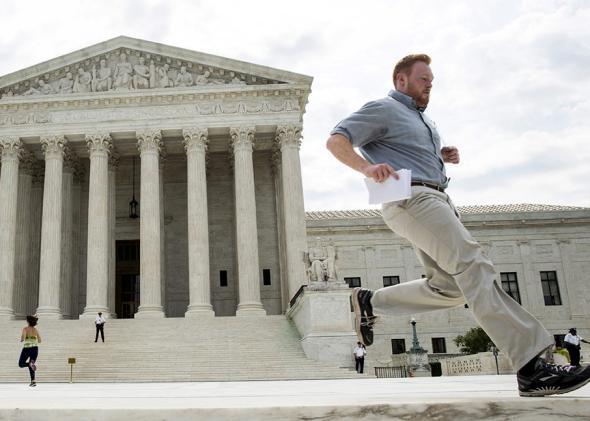On Thursday, in a 5–4 opinion written by Justice Anthony Kennedy and joined by Justices Ruth Bader Ginsburg, Stephen Breyer, Sonia Sotomayor, and Elena Kagan, the Supreme Court held that the 1968 Fair Housing Act—passed in the wake of Martin Luther King’s assassination, huge riots, and urban destruction—allows federal action against “disparate impact” as well as overt discrimination. This ruling not only affirms an essential tool in combating racial discrimination, it upholds the view that racial disparities are a national problem that the government ought to combat.
Disparate impact—the idea that, whether intentional or not, something is discriminatory and illegal if it has a disproportionate “adverse impact” on a particular group—is easy to understand, on account of its universal presence in the United States. Explicit racial bias is frowned on and most Americans strive for tolerance and fair treatment. Yet, there are vast racial gaps in almost every part of American life, from incarceration and the criminal justice system, to education, health care, and even air quality. While it’s tempting to blame “personal responsibility” or a nebulous “culture of poverty,” neither can explain broad trends of racial inequality that snare minorities of all education and income levels. Put simply, racism is so embedded in the structure of American society—from how we distribute wealth to how we determine punishment—that neutral, “colorblind” actions can easily produce unequal, racist results.
This is most apparent in housing, where cities and towns can create and bolster segregation through exclusionary zoning, and banks can target minorities for the worst, and most dangerous, mortgage loans. Both practices have disproportionately hurt blacks and Latinos, and both practices have been targeted for lawsuits and federal investigation. The main tool for this is the “disparate impact claim,” which identifies discrimination, connects it to a certain policy or practice, and ties it to real-life outcomes. Without the disparate impact portion of the Fair Housing Act, this wouldn’t be possible, and the federal government would lose an essential method for combating the types of discrimination that still define the terms of our housing markets. “Landlords, housing professionals, zoning and planning boards, have learned to stop talking about [discrimination],” the head of enforcement for the Department of Housing and Urban Development said two years ago in describing the importance of the disparate impact standard. “What they haven’t learned is to stop doing it.”
In Texas Department of Housing and Community Affairs v. the Inclusive Communities Project, a nonprofit group that promotes racial and socioeconomic integration in the Dallas area sued the state of Texas for racial segregation in subsidized housing. Here’s how Amy Howe described the dispute for SCOTUSblog:
As part of [its] mission, the [Inclusive Communities] Project tries to help lower-income African-American families find affordable housing, for which they receive subsidies in the form of a voucher, in the mostly white suburbs of Dallas. To do so, those families have to find a landlord who will accept the voucher; most private landlords decline to do so, but landlords who receive federal tax credits for lower-income housing are required to do so. Those tax credits are distributed by state government agencies, such as the Texas Department of Housing and Community Affairs. Because the state agencies determine where to allocate the tax credits, they can affect the housing options available to lower-income families like the Project’s clients.
In 2008, the Project filed this lawsuit against the state agency. It argued that the agency had allocated the tax credits in a racially segregated manner: it disproportionately granted the housing credits in minority areas of the Dallas region, while at the same time disproportionately denying them in white areas of Dallas.
The Fair Housing Act prohibits discrimination but doesn’t specify the kind of discrimination. Defending itself, the state of Texas argued that the FHA is limited to intentional discrimination and that disparate impact claims are invalid. The Inclusive Communities Project, by contrast, pointed to the text of the FHA, arguing that Congress passed the act to correct for intentional racial segregation and housing practices that continued existing segregation. What’s more, as the Obama administration stressed in its support for the project’s lawsuit, Congress gave the federal government “broad authority to administer” the law, which—the administration says—“focuses on the consequences of the action … rather than the motivation of the actor.”
The Supreme Court agreed. And while Kennedy’s majority opinion came with caveats—specifically in reference to racial quotas—he ultimately sided with precedent and against the court’s conservatives, who have opposed broad anti-discrimination laws as a matter of principle. (Indeed, in his dissent, Justice Clarence Thomas cited black Americans’ presence in the NBA as evidence that racial disparities weren’t inherently bad. Seriously.) “The Court acknowledges,” wrote Kennedy, “the Fair Housing Act’s continuing role in moving the Nation toward a more integrated society.”
To be clear, the court hasn’t struck a blow against housing discrimination, it has just maintained the status quo. While the Obama administration has been more aggressive with the Fair Housing Act than its predecessors, there’s still tremendous work to do before the United States has a genuinely fair housing market. But this ruling clarifies the FHA and preserves its broad scope for action.
It’s also important to note one final thing: Among the towns involved with the Inclusive Communities Project was McKinney, Texas, where earlier this month a pool dispute—sparked when a white patron told black guests to “go back to Section 8 housing”—turned into yet another instance of police brutality as an officer pinned a teenaged girl to the ground and arrested her.
McKinney is divided along an east-west line. Blacks are on the east, whites are in the west, and the pool—a private communal facility—was located on the white side of town. In standing with the project, the Supreme Court did more than uphold the Fair Housing Act, it sent a message: This kind of exclusion—this kind of treatment—is unacceptable.
